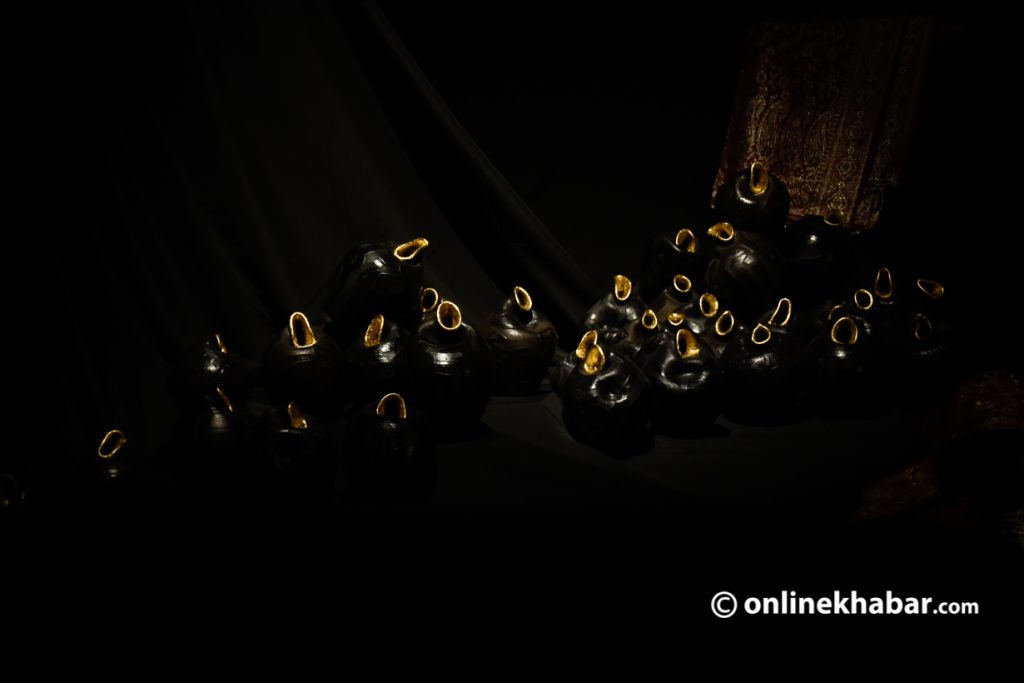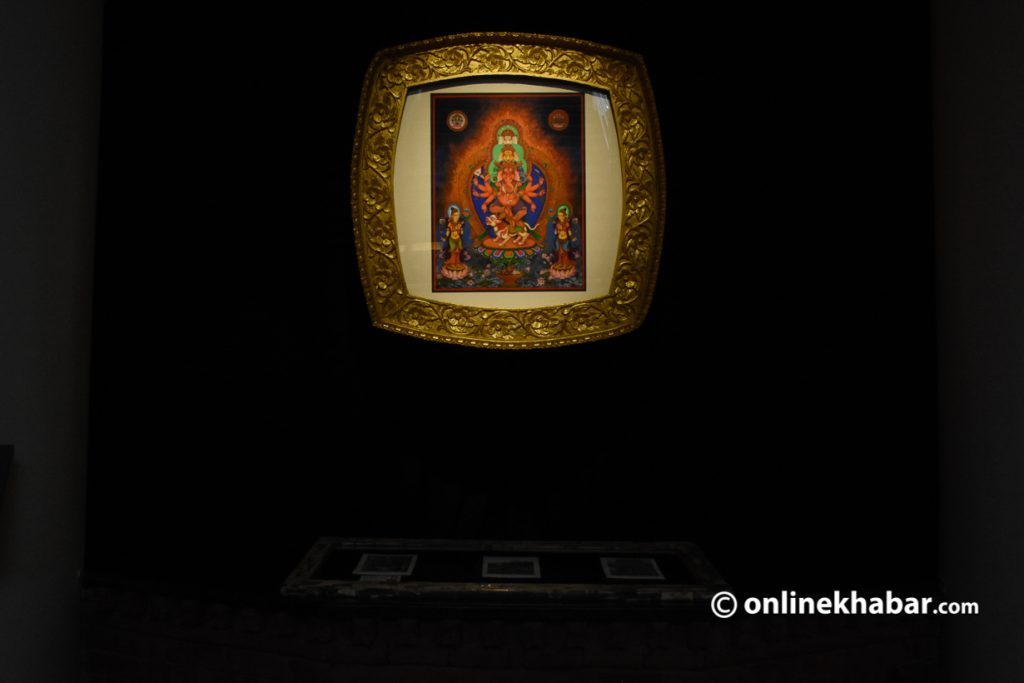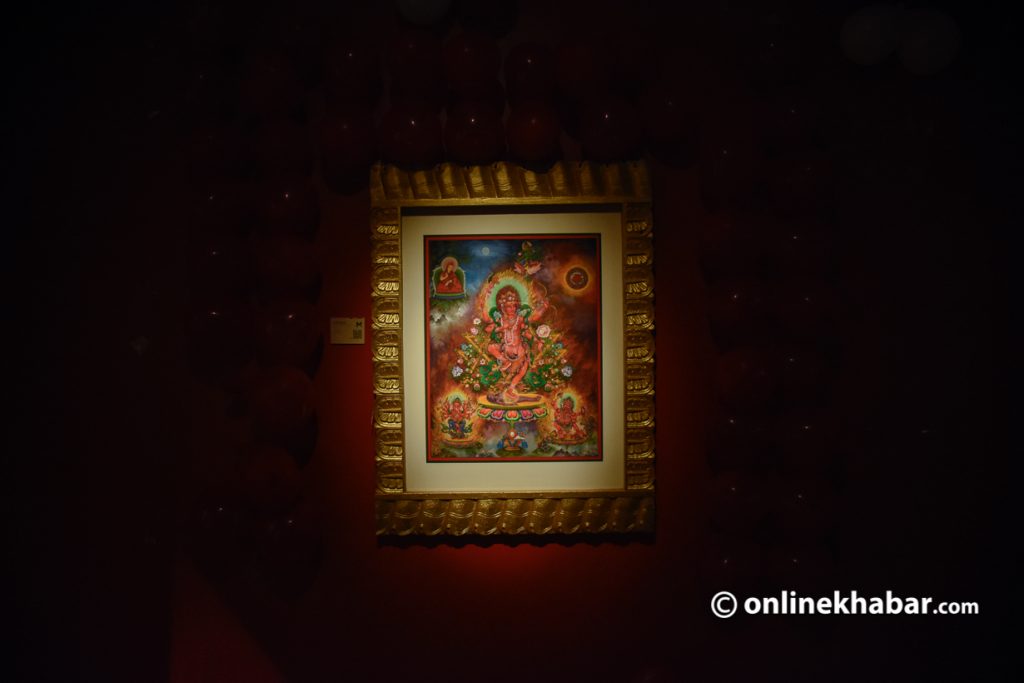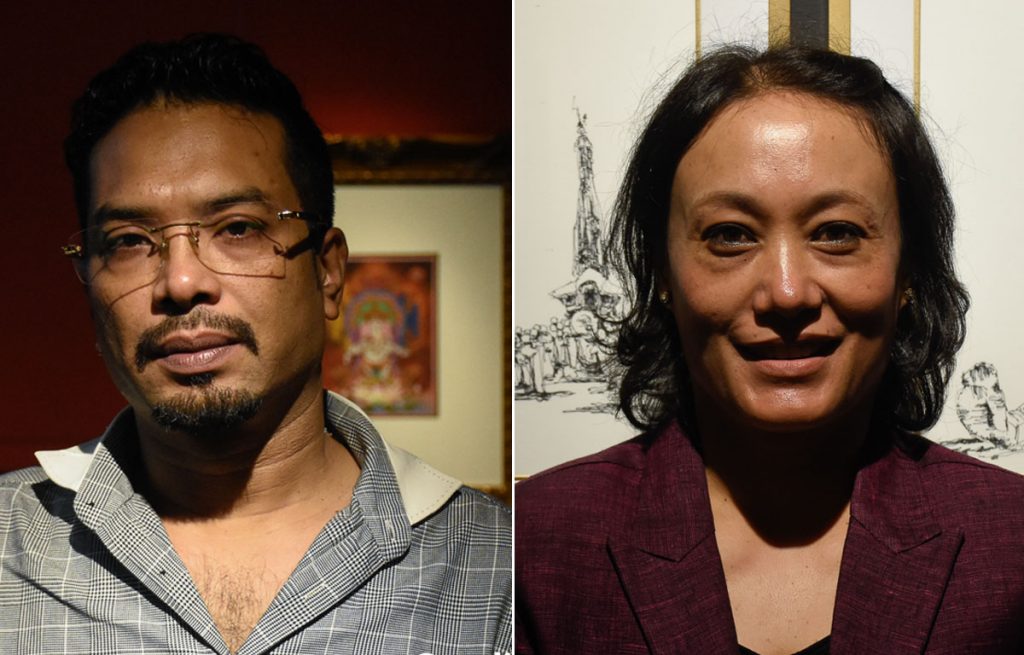
Museum of Nepali Art (MONA), Thamel, is exhibiting artworks by traditional artist Raj Prakash Man Tuladhar and visual artist Sushila Singh. The exhibition has amalgamated traditional and modern art in one single space. In essence, it gives you a feel of visiting two different solo exhibitions in one venue.
The curator has managed the artworks in such a way that neither of their works overpowers the other. All the artworks on display are in the museum’s permanent collection. According to the artists, this is the beauty of exhibiting in a museum rather than in a gallery. These artists felt valued as their works stay within the country.
Moreover, the curatorial part of the exhibition has enhanced the meaning of artworks created by these traditional and modern artists. The lighting and the utilisation of space have enhanced the aesthetic aspect of the artworks displayed in the exhibition.
The remainder of the roots
As you enter the museum’s gallery, the first thing that welcomes you is the paubha painting of Lord Ganesh by Raj Prakash Man Tuladhar in a golden frame. Then, on your left, there are the artist’s tools displayed in a glass showcase. Then, there are other paubha paintings created by Tuladhar.

Except for Lord Ganesh, the artist has created paubha of Padmasambhava, Goddesses Tara, Bajrayogini, Kurukulla and more.
“Paubha painting is not just an art for religious purpose, but it contains the philosophy of life. That’s the beauty of paubha. Moreover, the motif of Lord Ganesh carries the philosophy of life. It says whenever you are going out of your house, you should be like Lord Ganesh. Ganesh’s facial features and physique symbolises different actions one should acknowledge. For example, small eyes denote one should look into details, big ears mean one should listen and the mouth covered by a trunk symbolises one should talk less.”
Moreover, in the exhibition, there is an interesting scenario where the paubha painting of Goddess Kurukulla is surrounded by red and white balloons and next to it is a beautifully set table with roses, candles and balloons for two.
This definitely creates curiosity in the viewers. About this mix and match, Rajan Sakya, the founder and also the curator of the exhibition, explains, “The balloons and table set are placed intentionally so that it could create a discourse. Moreover, today’s generation follows and knows more about borrowed tradition and culture like Valentine’s Day, but is unknown about their own heritage. Goddess Kurukulla is the goddess of desire and love. The table is set to remind us that in our culture too, there are symbols and traditions for celebrating and cherishing love.”

According to him, Kurukulla is the goddess of love and to evoke some knowledge of already existing culture and heritage, he used the balloons and table set so that today’s generation can also relate to the idea and know their heritage.
Meanwhile, as you move to pass Goddess Kurukulla, there is a dim chamber where broken wooden structures are placed near the paubhas on the wall.
Though it is Tuladhar’s paintings, these are only the prints where the original masterpieces have been taken outside Nepal.
According to Sakya, these are additionally displayed to serve as reminders—what if all the masterpieces were removed from the country and people were forced to travel to foreign museums to learn about their own art and heritage? Additionally, this has been a component of the exhibition in order to make the younger generation aware of it.
Then, the photographs of temples in black and white accompany the paubha paintings, which indeed is a new concept. These are placed to show the relevance of paubha paintings to the temples of the gods and goddesses, which are a part of exhibited paubha paintings.
“As people frequently travel by these temples, this enables viewers to understand and relate to the paubha paintings on display, letting them understand the philosophical foundation of the paintings as well,” adds Sakya.
Exploring life
Meanwhile, visual artist Sushila Singh has explored herself in her installations, ceramics and drawings exhibited at MONA. Everyday items like clothes of her children, toys and more have become parts of her artworks.
Like the title of her exhibit Beautiful Chaos, the curator has justified it where her ceramics, ink and pen drawings are placed in a jumbled way, but the scenario is a pleasant one. It is a refreshing feeling viewing something that is simple, ordinary yet meaningful.
In the exhibition, 16 drawings using pen and ink on white paper are on display. These are her way of documenting the process of chariot making of Rato Machhindranath. Meanwhile, for these drawings, a chamber has been created and it is decorated with strings of jute rope and tuala kaapa (red and white cotton clothes used for religious purposes) on the top and between the drawings. These items always are a part of the outstanding chariot.

Moreover, these drawings have a confident strike of lines using pen and ink. Since the first day of the chariot’s construction this year, Singh has made daily trips to Pulchok and did the live drawings.
She wished to demonstrate the labour that went into building the magnificent chariot since anything beautiful and significant needs time. However, this time, due to time constraints, she could not draw the people who built the chariot.
Likewise, according to her, each and every artwork displayed in the exhibition has the involvement of her family.
The mother of two, through her installations, also questions society about why women are not allowed to be women. She says society does treat them either as goddesses or as nothing (but not women).
The corner of the museum is dedicated to this installation where numerous black clay piggy banks are clustered together and a few clusters of them are placed randomly on a black platform. There are her personal belongings such as her wedding dress, shoes, etc.

“The notion of treating women either as goddesses or as nobody is unbearable to me. Hence, through my installation work of ceramics using black and black technique and etching, I tried to show my journey as a woman. The black clay piggy banks are also the symbol of the wombs. Moreover, the black colour depicts the unnecessary things society talks about a woman then the golden colour on the top depicts that she is as pure as gold. And those piggy banks also symbolise all the women in my life.”
A relevant perspective

Suman Shakya, also a traditional artist, says he was happy to see both traditional and modern artworks displayed together. “I don’t find any difference in the creation of traditional and modern art. They have the essence of the artists. The only difference that I find is in traditional art, if you have knowledge beforehand about the philosophy of artwork, it will be more meaningful to you. However, in modern art, you can understand its philosophy on the spot by analysing them and interpreting accordingly, which I felt connected.”
According to him, the exhibition is quite different from any other exhibitions he had been to as this exhibition has given the platform to both traditional and modern artworks, which sometimes are considered the opposite. “As I was looking at Sushila’s work, I felt myself in her work. Being in a family and being an artist, children do interfere with your work but you still continue to do, which is life.”
Meanwhile, curator Rajan Sakya emphasises, “This time, we have curated traditional and modern art in a different way so that the younger generation too can relate to them and get curious about them. Without their interest, our art and heritage can simply die.”
“Art should be relevant (to the young people). Otherwise, people just ignore it and ignorance can lead to the extinction of our art, culture and heritage.”
The exquisite exhibition that began on July 17 is likely to continue for around two months.
The post Traditional and modern artworks complement each other in this Kathmandu exhibition appeared first on OnlineKhabar English News.
Comments
Post a Comment